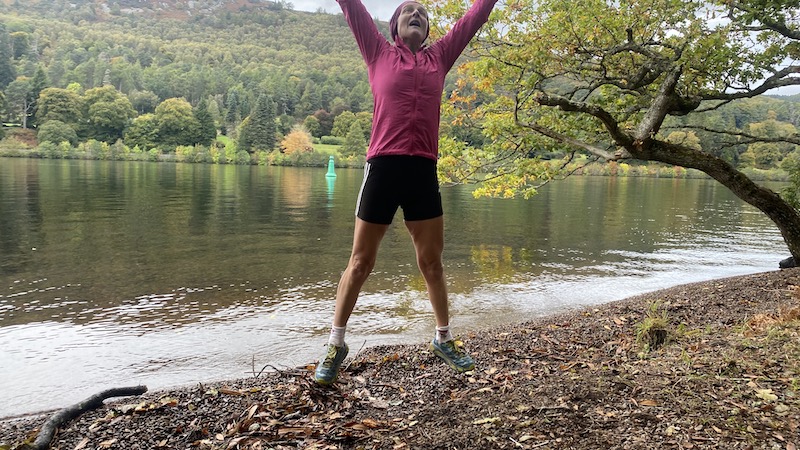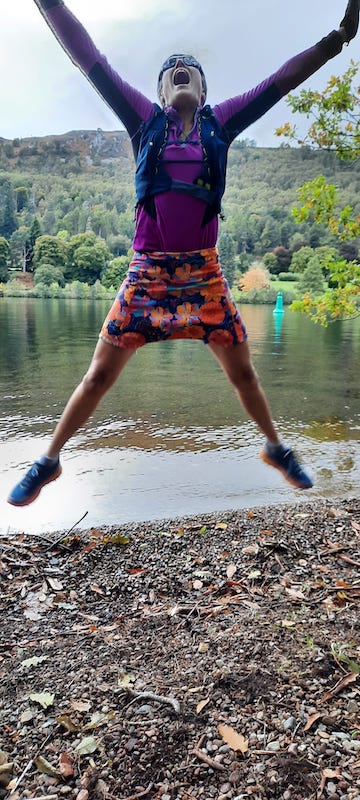Moving to the Highlands has introduced me to an outdoors activity that I was sure `I would never enjoy. But I am now a huge fan of wild swimming. These are some of the things I’ve learned over the last five months about swimming in open water.


Wild swimming: For pleasure not training
Years ago, when I participated in triathlon, an open water swim meant a training session. Usually, this required me to be focused on swimming for a set time or distance.
Swimming was always my weaker discipline and I rarely enjoyed it. I found I needed a lot of effort for swimming, compared to running and cycling, and because I had to work hard in the water, I didn’t enjoy the experience.
There were a few times when I suddenly “got it” and understood why people rave about being in open water but most of the time I found it too difficult, overwhelming and rather unpleasant. It did get easier the more frequently I swam but it was only ever about training for an event for me.
Now I enjoy swimming for pleasure. I go in for what I think of as a “dip”. When I do swim, it’s not about the distance but about enjoying the activity and simply being in the water.
I do breast-stroke instead of freestyle – and I chat to a friend. I sometimes go for a run, then a loch dip and then run again.
I enjoy being immersed in the water and I choose to swim or splash about as I want.
I switched my view from training to a simple outdoors activity and it has totally changed my mindset on wild swimming.

Smaller is better for me
I have had several panic attacks in open water and always in large bodies of water, such as Loch Lomond and a reservoir.
For as long as I can recall, I have been anxious about deep water and large expanses of water. I have never been a big fan of swimming in the sea.
When I moved to the Highlands I spotted a small local loch and this is where I have discovered a joy of wild swimming. I have swum in a few more “smaller” lochs since and I find I am much more comfortable in these.
I am not sure why this should be because I am a competent swimmer and I don’t feel the need to be close to the shore. The lochs I now frequent might be small but some are deep as well.
I can’t explain why I prefer being in a smaller area of water but it has made a huge difference to my confidence and how much I enjoy being in the water.

A slow build up makes sense
I knew that it was a good idea to build up time in cold water but I have never been keen enough to be a regular swimmer.
Now I go in the cold water once or twice each week. I have been doing this consistently for months and it makes a huge difference to how I feel when I first get into the loch or sea.
It is still cold on first entrance to the water, but I have the confidence and experience to know it will ease quickly.
I am convinced that the more you go, the easier it is to get in the water and the more acclimatised you feel. I know this might sound obvious, but until you experience it you can’t know for sure.

It’s great to explore
I am discovering more places to swim in open water thanks to new friends and a new locality. Now I enjoy the activity, I am much more open to trying new lochs and I even swam in the sea this month.
I take the time to look about me as I swim and enjoy the views and the surroundings.

I prefer ‘skins’ to a wetsuit
Before this summer, I had rarely been in open water in Scotland without a wetsuit. To me, it felt too cold.
When I moved north, I decided to brave the loch water in only a swimming costume to see how it went. It was a fairly warm summer’s day and I thought I’d give it a try.
Swimming “skins” is so free and easy. Because I don’t need to worry about how long I am in for, or completing a swimming session, I know I can get out when I start to feel cold.
It is now almost mid-October and I am still resisting using a wetsuit.
The other advantage of a swimming without a wetsuit is that you have less to carry to the loch or the sea. I enjoy swimming mid-way through a run and so I don’t want a heavy rucksack to carry.
However, I will definitely be swimming in a wetsuit as it gets colder. I know there are swimmers who say that they only ever swim “skins” but I am sure I’ll enjoy the experience more in winter in a good wetsuit.

There are neoprene accessories!
Even on a warm summer’s day, I suffer with cold hands and feet. I have Raynauld’s syndrome, which means my circulation is poor.
Wearing neoprene gloves and socks has been a revelation. I don’t think you are allowed to wear neoprene gloves for triathlon races so it was never an option before but now that I wild swim for pleasure and not to race, I can enjoy the benefits of neoprene accessories.
I have:

C-Skins Wired Glove 3mm 
Neoprene swimming gloves: C Skins 3mm wired neoprene gloves. (£42) (I see there are some sizes on Amazon and other sizes in C Skins Legend gloves (£32 to £35).
I might go buy 5mm gloves for the winter.
Neoprene swimming socks: I have two pairs, Lomo TRI-X Performance swimming socks (£19.99) and Orca swim socks (£35) (spotted for £29.99 on Amazon.)
I like them both. Of note with the Lomo socks are the neat and grippy fit at the ankle. They are a better fit for people with wider feet and larger calves.
I like the Orca socks because they fit my narrow feet neatly all over, like an ordinary sock. I have really slim feet and these seem to work well for me.
Neoprene swim hat: I have owned a neoprene swim hat for years and I have no idea what the brand is. Choose one with chin strap so it stays in place and wraps around your ears for better warmth. I wear an ordinary silicon swim hat underneath.
Neoprene swim vest: My latest great discovery is a swimming vest. I have an Orca Heatseeker vest (£54).( See Amazon, too, priced at £44.95 as this was published.) It is made with 2mm neoprene. I put it on over my swimming costume and it makes an amazing difference to general warmth.
Last week, my friend Karen, who has a neoprene swimsuit, and I, wearing my Heatseeker vest, are able to swim for longer than the weeks before. We were surprised by how much warmer we felt in the water and how much longer we could swim for.

I will no doubt progress to wearing a swim wetsuit – I have the Orca TRN Core (£169) (also for sale on Amazon) – and then I will probably add the Orca Heatseeker vest underneath.

It’s a great new adventure
I love a new adventure and this feels like a great one for me to try now that I live in the Highlands. Firstly, there are local lochs and the sea close by, but also there are plenty of great options across the region now that I feel more confident with the activity.
Wild swimming is better with friends
I have met new friends since moving to the Black Isle and I really enjoy wild swimming with some of them. I have also encouraged visiting friends to swim in open water, too.
It’s a great way to enjoy time together surrounded by nature. We swim breaststroke most of the time and chat.
Usually, at some point in the swim, one of us will exclaim our utter joy at being so fortunate to be able to experience such an amazing activity and environment.
Don’t get too cold
It seems obvious doesn’t it, but there is a danger that you become so cold that getting out is horrid. I always try to get out as soon as I think to myself that I am feeling a bit chilly.
I swim with people who understand that I might not last as long as them in cold water and there is no pressure to stay in for longer.
If I get out when I know I should I find it easier to warm top afterwards. Getting too cold can be dangerous because if your body temperature dips too low you may end up hypothermic. There is an issue called “after drop”, where your body temperature continues to fall even when you think you have done everything to warm up.
Even at its mildest, the start of hypothermia can make you feel dizzy, nauseous and a bit uncoordinated.
I know that my hands will take a long time to thaw if I stay in the cold water for too long.
When I get out, I quickly dry myself and change into dry clothes. I take extra layers, as well as gloves, even in summer. It is a good idea to have an over-the-head towel or a dry robe of some kind to keep the wind-chill from wet and cold skin.
Building up the time you spend in cold water really does help with how you cope afterwards as well.
Dizziness can be a problem
I find that cold water in my ears if I swim too vigorously with my head under the water can lead to a dizziness and nausea when I get out of the water.
One suggestion is to wear ear-plugs. Dizziness, as I’ve mentioned above, can be a sign of hypothermia, too, so you should try to limit your time in very cold water and/or build up your acclimatisation process.
It feels amazing
As I said before, I never imagined I’d be a fan of open water swimming but I really like it now. Whether I’m in for a few minutes or for a longer swim, I always come out feeling buzzy and euphoric.
Many people say there are physical and mental health benefits to regular cold water swimming and I believe this.
I will see how I go as the winter progresses and the water gets colder. I know I’ll be wearing a wetsuit soon.









